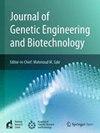垃圾场分离的具有蛋白酶产量的萨氏芽孢杆菌Z1,具有潜在的工业用途
IF 2.8
Q3 Biochemistry, Genetics and Molecular Biology
Journal of Genetic Engineering and Biotechnology
Pub Date : 2025-08-05
DOI:10.1016/j.jgeb.2025.100543
引用次数: 0
摘要
蛋白酶,特别是来自微生物的蛋白酶,由于其成本效益、多功能性和可持续性,在各个行业中已经成为不可或缺的。它们为传统的动物和植物酶提供了一种更高效、更环保的替代品。在这方面,从西顿垃圾场收集的水样进行了筛选,以确定它们产生蛋白酶的能力。该菌株在脱脂乳琼脂上表现为阳性,因此被选为蛋白酶产生菌株。分离株在脱脂牛奶琼脂平板上进行检测。在6株分离菌株中,鉴定出最有效的菌株为萨氏芽孢杆菌Z1。最佳的蛋白酶活性和微生物生长参数(时间、pH、温度)为48 h, pH为7,温度为40℃。采用盐沉淀法对酶进行均相纯化。SDS-PAGE证实分离酶分子量约为50 kDa。PMSF显著抑制其表达,表明其属于丝氨酸蛋白酶家族。该酶对表面活性剂和商用洗涤剂的耐受性表明其在洗涤剂工业中的潜在应用。此外,部分纯化的酶表现出去除污渍和羽毛分解的能力。本文章由计算机程序翻译,如有差异,请以英文原文为准。
A dumpsite-isolated Bacillus safensis Z1 with protease yield for potential industrial use
Proteases, particularly those derived from microbial sources, have become indispensable in various industries due to their cost-effectiveness, versatility, and sustainability. They provide a more efficient and environmentally friendly alternative to traditional animal- and plant-based enzymes. In this regard, water samples collected from the Sidon dump site were screened for their ability to produce protease. The isolates showed positive results on skim milk agar and were therefore selected as protease-producing strains. The isolates were tested on skim milk agar plates. Of the 6 isolated strains, the most potent isolate was identified as Bacillus safensis Z1. Optimized parameters (time, pH, temperature) for maximum protease activity and microbial growth of B. safensis Z1 include 48 h, pH 7, at 40 °C. The enzyme was homogeneously purified by salt precipitation. SDS-PAGE confirmed that the isolated enzyme had a molecular weight of approximately 50 kDa. It was significantly inhibited by PMSF, indicating that it belongs to serine protease family. The enzyme’s tolerance with surfactants and commercial detergents indicates its potential application in the detergent industry. Furthermore, the partially purified enzyme demonstrated stain removal and feather disintegration capabilities.
求助全文
通过发布文献求助,成功后即可免费获取论文全文。
去求助
来源期刊

Journal of Genetic Engineering and Biotechnology
Biochemistry, Genetics and Molecular Biology-Biotechnology
CiteScore
5.70
自引率
5.70%
发文量
159
审稿时长
16 weeks
期刊介绍:
Journal of genetic engineering and biotechnology is devoted to rapid publication of full-length research papers that leads to significant contribution in advancing knowledge in genetic engineering and biotechnology and provide novel perspectives in this research area. JGEB includes all major themes related to genetic engineering and recombinant DNA. The area of interest of JGEB includes but not restricted to: •Plant genetics •Animal genetics •Bacterial enzymes •Agricultural Biotechnology, •Biochemistry, •Biophysics, •Bioinformatics, •Environmental Biotechnology, •Industrial Biotechnology, •Microbial biotechnology, •Medical Biotechnology, •Bioenergy, Biosafety, •Biosecurity, •Bioethics, •GMOS, •Genomic, •Proteomic JGEB accepts
 求助内容:
求助内容: 应助结果提醒方式:
应助结果提醒方式:


